

Compact Muon Solenoid
LHC, CERN
| CMS-PAS-HIG-22-008 | ||
| Constraints on anomalous Higgs boson couplings from its production and decay in the WW channel | ||
| CMS Collaboration | ||
| 19 September 2023 | ||
| Abstract: A study of the Higgs boson anomalous couplings from its production and decay in the WW channel is presented. The proton-proton collision data set was collected with the CMS detector at the CERN LHC during 2016-2018, and corresponds to an integrated luminosity of 138 fb$ ^{-1} $ at a center-of-mass energy of 13 TeV. Couplings of the Higgs boson to vector bosons are studied including CP-violation effects. The different-flavor dilepton (e$\mu $) final state is analysed, with dedicated categories targeting gluon fusion, electroweak vector boson fusion, and associated production with a W or Z boson. Kinematic information from associated jets is combined using matrix element techniques to increase the sensitivity to anomalous effects at the production vertex. A simultaneous measurement of four Higgs boson couplings to electroweak vector bosons is performed in the framework of a standard model effective field theory. All measurements are consistent with the expectations for the standard model Higgs boson and constraints are set on the fractional contribution of the anomalous couplings to the Higgs boson cross section. | ||
|
Links:
CDS record (PDF) ;
CADI line (restricted) ;
These preliminary results are superseded in this paper, Submitted to EPJC. The superseded preliminary plots can be found here. |
||
| Figures | |

png pdf |
Figure 1:
Topologies of the Higgs boson production and decay for vector boson fusion $ \mathrm{q}{\mathrm{q}^\prime}\to \mathrm{q}{\mathrm{q}^\prime} \mathrm{H} $ (left), $ \mathrm{q}\bar{\mathrm{q}}^\prime\to \mathrm{V}\mathrm{H} $ (center), and gluon fusion with decay $ \mathrm{g}\mathrm{g} \to \mathrm{H} \to 2 \ell 2\nu $ (right). For the electroweak production topologies, the intermediate vector bosons and their decays are shown in green while the $ \mathrm{H} \to \mathrm{W}\mathrm{W} $ decay is shown in red. For the $ \mathrm{g}\mathrm{g} \to \mathrm{H} \to 2 \ell 2\nu $ topology, the W boson leptonic decays are shown in green. In all cases, the incoming particles are shown in brown and the angles characterizing kinematic distributions are shown in blue. Five angles fully characterize the orientation of the production and decay chain and are defined in the suitable rest frames. |
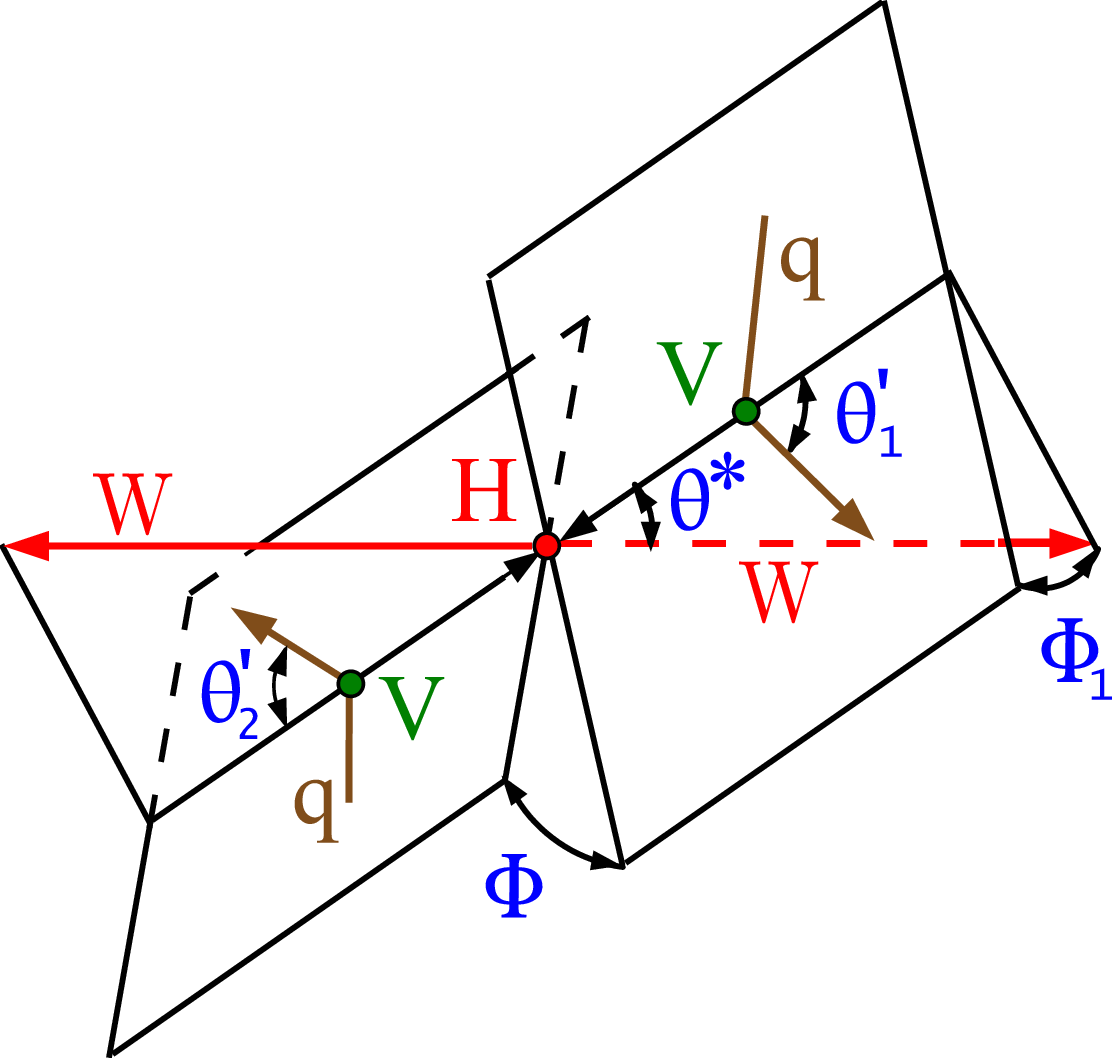
png pdf |
Figure 1-a:
Topologies of the Higgs boson production and decay for vector boson fusion $ \mathrm{q}{\mathrm{q}^\prime}\to \mathrm{q}{\mathrm{q}^\prime} \mathrm{H} $ (left), $ \mathrm{q}\bar{\mathrm{q}}^\prime\to \mathrm{V}\mathrm{H} $ (center), and gluon fusion with decay $ \mathrm{g}\mathrm{g} \to \mathrm{H} \to 2 \ell 2\nu $ (right). For the electroweak production topologies, the intermediate vector bosons and their decays are shown in green while the $ \mathrm{H} \to \mathrm{W}\mathrm{W} $ decay is shown in red. For the $ \mathrm{g}\mathrm{g} \to \mathrm{H} \to 2 \ell 2\nu $ topology, the W boson leptonic decays are shown in green. In all cases, the incoming particles are shown in brown and the angles characterizing kinematic distributions are shown in blue. Five angles fully characterize the orientation of the production and decay chain and are defined in the suitable rest frames. |
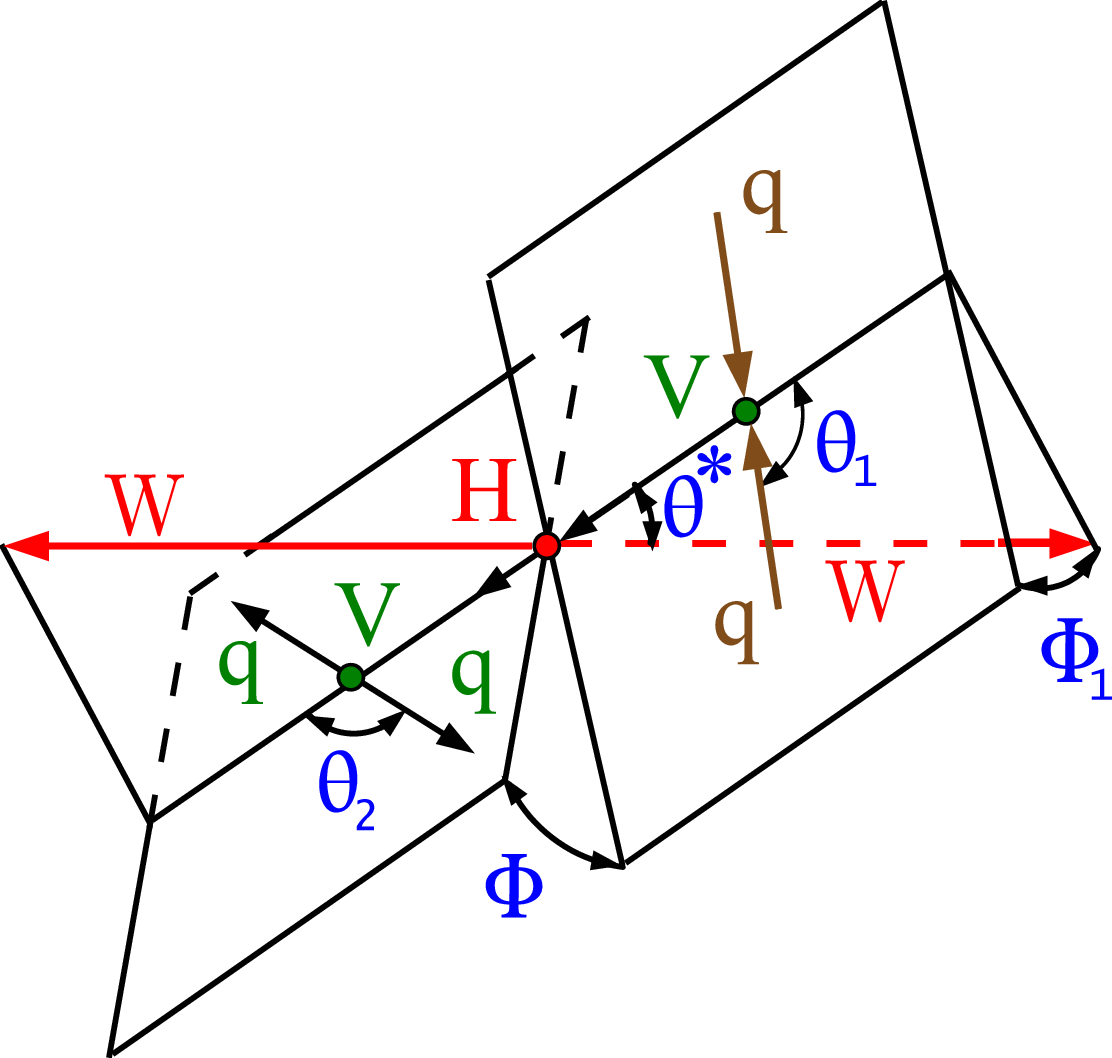
png pdf |
Figure 1-b:
Topologies of the Higgs boson production and decay for vector boson fusion $ \mathrm{q}{\mathrm{q}^\prime}\to \mathrm{q}{\mathrm{q}^\prime} \mathrm{H} $ (left), $ \mathrm{q}\bar{\mathrm{q}}^\prime\to \mathrm{V}\mathrm{H} $ (center), and gluon fusion with decay $ \mathrm{g}\mathrm{g} \to \mathrm{H} \to 2 \ell 2\nu $ (right). For the electroweak production topologies, the intermediate vector bosons and their decays are shown in green while the $ \mathrm{H} \to \mathrm{W}\mathrm{W} $ decay is shown in red. For the $ \mathrm{g}\mathrm{g} \to \mathrm{H} \to 2 \ell 2\nu $ topology, the W boson leptonic decays are shown in green. In all cases, the incoming particles are shown in brown and the angles characterizing kinematic distributions are shown in blue. Five angles fully characterize the orientation of the production and decay chain and are defined in the suitable rest frames. |
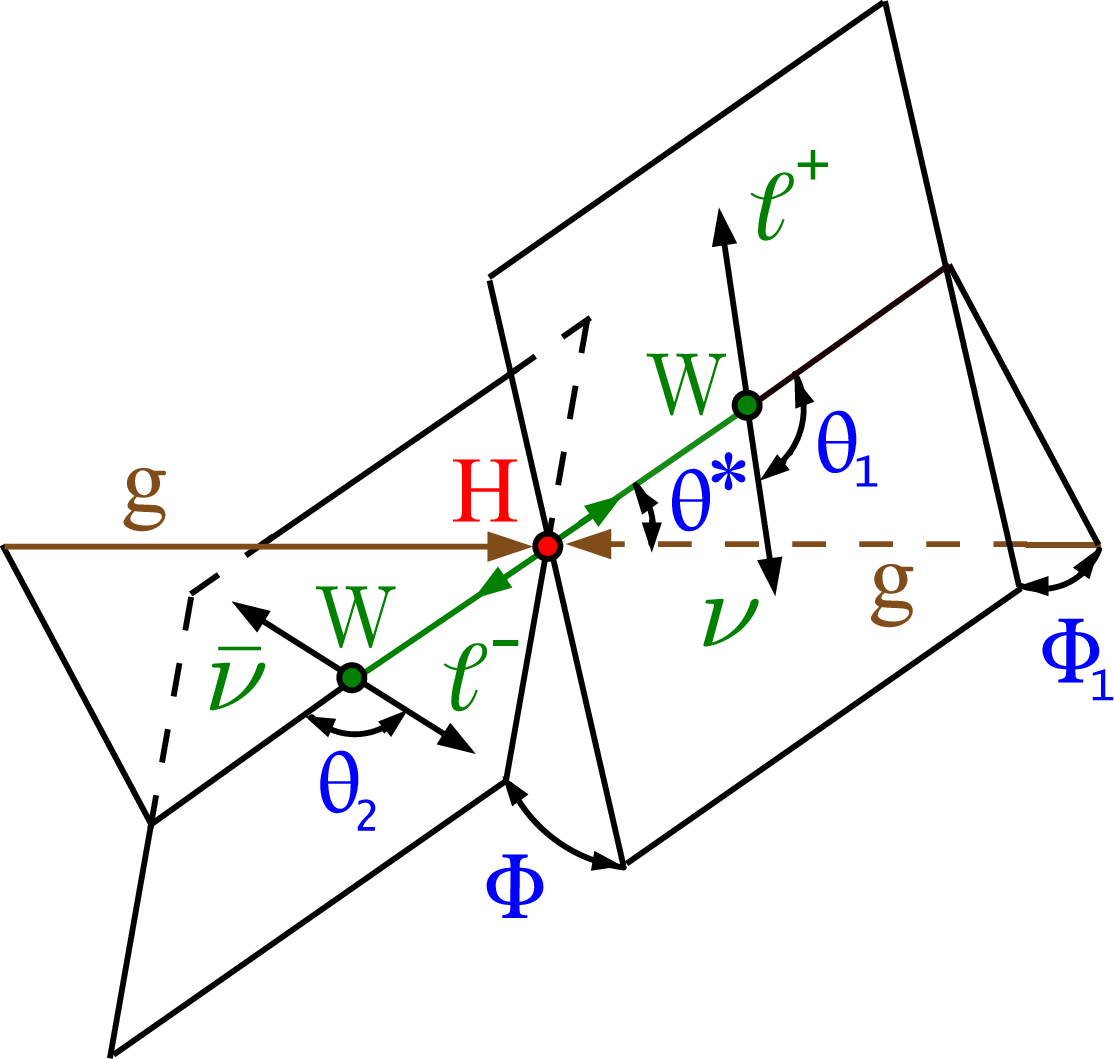
png pdf |
Figure 1-c:
Topologies of the Higgs boson production and decay for vector boson fusion $ \mathrm{q}{\mathrm{q}^\prime}\to \mathrm{q}{\mathrm{q}^\prime} \mathrm{H} $ (left), $ \mathrm{q}\bar{\mathrm{q}}^\prime\to \mathrm{V}\mathrm{H} $ (center), and gluon fusion with decay $ \mathrm{g}\mathrm{g} \to \mathrm{H} \to 2 \ell 2\nu $ (right). For the electroweak production topologies, the intermediate vector bosons and their decays are shown in green while the $ \mathrm{H} \to \mathrm{W}\mathrm{W} $ decay is shown in red. For the $ \mathrm{g}\mathrm{g} \to \mathrm{H} \to 2 \ell 2\nu $ topology, the W boson leptonic decays are shown in green. In all cases, the incoming particles are shown in brown and the angles characterizing kinematic distributions are shown in blue. Five angles fully characterize the orientation of the production and decay chain and are defined in the suitable rest frames. |

png pdf |
Figure 2:
Distribution of events for $ [\mathcal{D}_\text{VBF}, m_{\ell\ell}, \mathcal{D}_{0-}] $ in the VBF channel (left), and for $ [m_{\ell\ell}, \mathcal{D}_{0-}] $ in the Resolved VH (center) and Boosted VH (right) channels. For each channel, the $ \mathcal{D}_{CP} < $ 0 (upper) and $ \mathcal{D}_{CP} > $ 0 (lower) categories are shown. The binning strategy for each discriminant is described in Section 8.1. The predicted Higgs boson signal and background distributions are shown after the fit to the data. For the fit, the $ a_{1} $ and $ a_3 \mathrm{H}\mathrm{V}\mathrm{V} $ coupling contributions are considered. The Higgs boson signal is shown both stacked on top of the backgrounds and superimposed. The uncertainty band corresponds to the total systematic uncertainty. The lower panel in each figure shows the ratio of the number of events observed to the total prediction. |
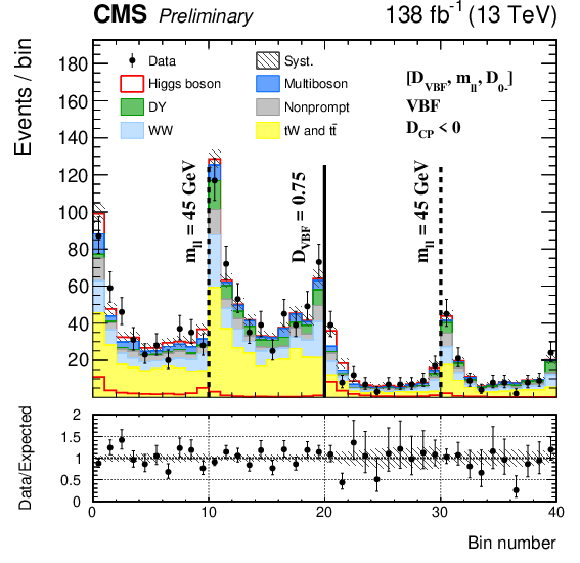
png pdf |
Figure 2-a:
Distribution of events for $ [\mathcal{D}_\text{VBF}, m_{\ell\ell}, \mathcal{D}_{0-}] $ in the VBF channel (left), and for $ [m_{\ell\ell}, \mathcal{D}_{0-}] $ in the Resolved VH (center) and Boosted VH (right) channels. For each channel, the $ \mathcal{D}_{CP} < $ 0 (upper) and $ \mathcal{D}_{CP} > $ 0 (lower) categories are shown. The binning strategy for each discriminant is described in Section 8.1. The predicted Higgs boson signal and background distributions are shown after the fit to the data. For the fit, the $ a_{1} $ and $ a_3 \mathrm{H}\mathrm{V}\mathrm{V} $ coupling contributions are considered. The Higgs boson signal is shown both stacked on top of the backgrounds and superimposed. The uncertainty band corresponds to the total systematic uncertainty. The lower panel in each figure shows the ratio of the number of events observed to the total prediction. |
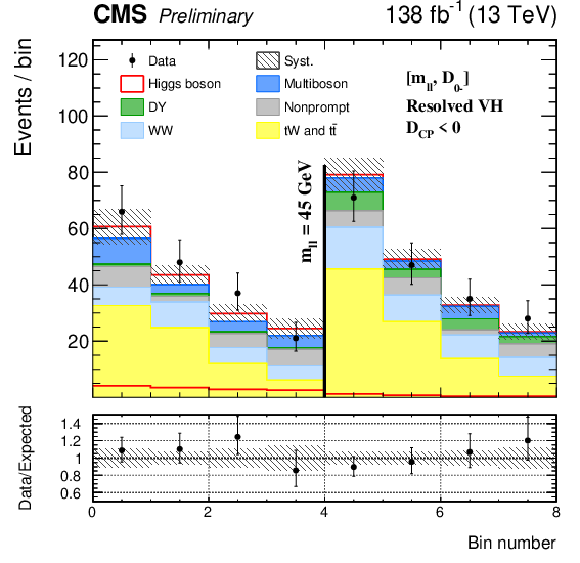
png pdf |
Figure 2-b:
Distribution of events for $ [\mathcal{D}_\text{VBF}, m_{\ell\ell}, \mathcal{D}_{0-}] $ in the VBF channel (left), and for $ [m_{\ell\ell}, \mathcal{D}_{0-}] $ in the Resolved VH (center) and Boosted VH (right) channels. For each channel, the $ \mathcal{D}_{CP} < $ 0 (upper) and $ \mathcal{D}_{CP} > $ 0 (lower) categories are shown. The binning strategy for each discriminant is described in Section 8.1. The predicted Higgs boson signal and background distributions are shown after the fit to the data. For the fit, the $ a_{1} $ and $ a_3 \mathrm{H}\mathrm{V}\mathrm{V} $ coupling contributions are considered. The Higgs boson signal is shown both stacked on top of the backgrounds and superimposed. The uncertainty band corresponds to the total systematic uncertainty. The lower panel in each figure shows the ratio of the number of events observed to the total prediction. |
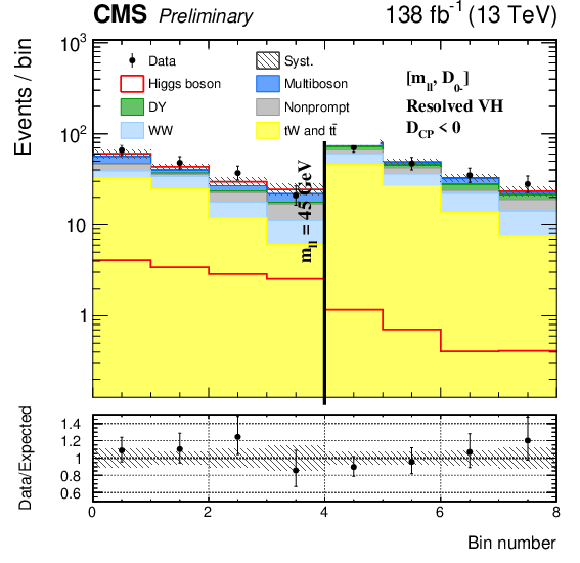
png pdf |
Figure 2-c:
Distribution of events for $ [\mathcal{D}_\text{VBF}, m_{\ell\ell}, \mathcal{D}_{0-}] $ in the VBF channel (left), and for $ [m_{\ell\ell}, \mathcal{D}_{0-}] $ in the Resolved VH (center) and Boosted VH (right) channels. For each channel, the $ \mathcal{D}_{CP} < $ 0 (upper) and $ \mathcal{D}_{CP} > $ 0 (lower) categories are shown. The binning strategy for each discriminant is described in Section 8.1. The predicted Higgs boson signal and background distributions are shown after the fit to the data. For the fit, the $ a_{1} $ and $ a_3 \mathrm{H}\mathrm{V}\mathrm{V} $ coupling contributions are considered. The Higgs boson signal is shown both stacked on top of the backgrounds and superimposed. The uncertainty band corresponds to the total systematic uncertainty. The lower panel in each figure shows the ratio of the number of events observed to the total prediction. |

png pdf |
Figure 2-d:
Distribution of events for $ [\mathcal{D}_\text{VBF}, m_{\ell\ell}, \mathcal{D}_{0-}] $ in the VBF channel (left), and for $ [m_{\ell\ell}, \mathcal{D}_{0-}] $ in the Resolved VH (center) and Boosted VH (right) channels. For each channel, the $ \mathcal{D}_{CP} < $ 0 (upper) and $ \mathcal{D}_{CP} > $ 0 (lower) categories are shown. The binning strategy for each discriminant is described in Section 8.1. The predicted Higgs boson signal and background distributions are shown after the fit to the data. For the fit, the $ a_{1} $ and $ a_3 \mathrm{H}\mathrm{V}\mathrm{V} $ coupling contributions are considered. The Higgs boson signal is shown both stacked on top of the backgrounds and superimposed. The uncertainty band corresponds to the total systematic uncertainty. The lower panel in each figure shows the ratio of the number of events observed to the total prediction. |

png pdf |
Figure 2-e:
Distribution of events for $ [\mathcal{D}_\text{VBF}, m_{\ell\ell}, \mathcal{D}_{0-}] $ in the VBF channel (left), and for $ [m_{\ell\ell}, \mathcal{D}_{0-}] $ in the Resolved VH (center) and Boosted VH (right) channels. For each channel, the $ \mathcal{D}_{CP} < $ 0 (upper) and $ \mathcal{D}_{CP} > $ 0 (lower) categories are shown. The binning strategy for each discriminant is described in Section 8.1. The predicted Higgs boson signal and background distributions are shown after the fit to the data. For the fit, the $ a_{1} $ and $ a_3 \mathrm{H}\mathrm{V}\mathrm{V} $ coupling contributions are considered. The Higgs boson signal is shown both stacked on top of the backgrounds and superimposed. The uncertainty band corresponds to the total systematic uncertainty. The lower panel in each figure shows the ratio of the number of events observed to the total prediction. |
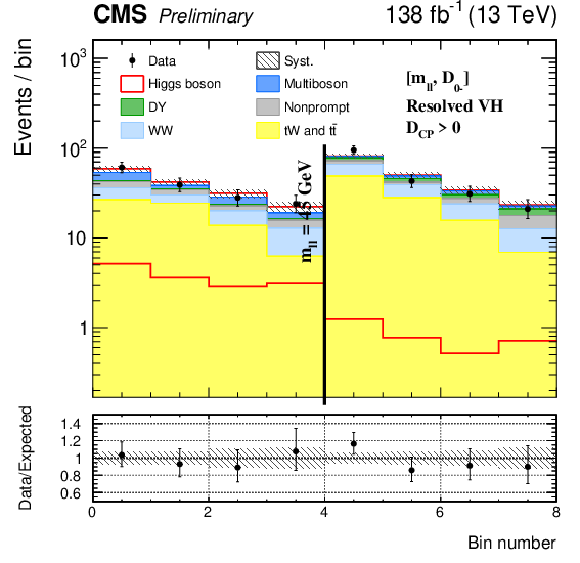
png pdf |
Figure 2-f:
Distribution of events for $ [\mathcal{D}_\text{VBF}, m_{\ell\ell}, \mathcal{D}_{0-}] $ in the VBF channel (left), and for $ [m_{\ell\ell}, \mathcal{D}_{0-}] $ in the Resolved VH (center) and Boosted VH (right) channels. For each channel, the $ \mathcal{D}_{CP} < $ 0 (upper) and $ \mathcal{D}_{CP} > $ 0 (lower) categories are shown. The binning strategy for each discriminant is described in Section 8.1. The predicted Higgs boson signal and background distributions are shown after the fit to the data. For the fit, the $ a_{1} $ and $ a_3 \mathrm{H}\mathrm{V}\mathrm{V} $ coupling contributions are considered. The Higgs boson signal is shown both stacked on top of the backgrounds and superimposed. The uncertainty band corresponds to the total systematic uncertainty. The lower panel in each figure shows the ratio of the number of events observed to the total prediction. |
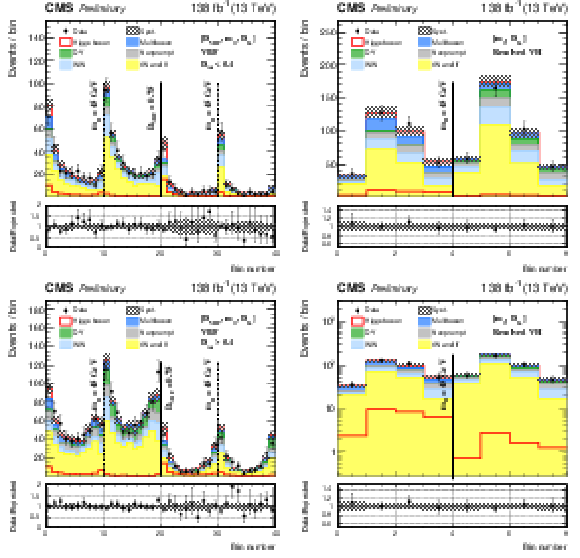
png pdf |
Figure 3:
Distribution of events for $ [\mathcal{D}_\text{VBF}, m_{\ell\ell}, \mathcal{D}_{0+}] $ in the VBF channel (left), and for $ [m_{\ell\ell}, \mathcal{D}_{0+}] $ in the Resolved VH (upper right) and Boosted VH (lower right) channels. For the VBF channel, the $ \mathcal{D}_{\text{int}} < $ 0.4 (upper left) and VBF $ \mathcal{D}_{\text{int}} > $ 0.4 (lower left) categories are shown. The binning strategy for each discriminant is described in Section 8.1. The predicted Higgs boson signal and background distributions are shown after the fit to the data. For the fit, the $ a_{1} $ and $ a_2 \mathrm{H}\mathrm{V}\mathrm{V} $ coupling contributions are considered. More details are given in the caption of Fig. 2. |

png pdf |
Figure 3-a:
Distribution of events for $ [\mathcal{D}_\text{VBF}, m_{\ell\ell}, \mathcal{D}_{0+}] $ in the VBF channel (left), and for $ [m_{\ell\ell}, \mathcal{D}_{0+}] $ in the Resolved VH (upper right) and Boosted VH (lower right) channels. For the VBF channel, the $ \mathcal{D}_{\text{int}} < $ 0.4 (upper left) and VBF $ \mathcal{D}_{\text{int}} > $ 0.4 (lower left) categories are shown. The binning strategy for each discriminant is described in Section 8.1. The predicted Higgs boson signal and background distributions are shown after the fit to the data. For the fit, the $ a_{1} $ and $ a_2 \mathrm{H}\mathrm{V}\mathrm{V} $ coupling contributions are considered. More details are given in the caption of Fig. 2. |
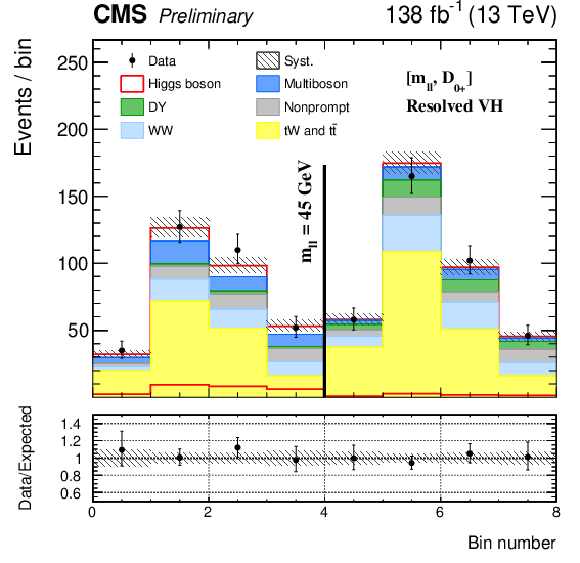
png pdf |
Figure 3-b:
Distribution of events for $ [\mathcal{D}_\text{VBF}, m_{\ell\ell}, \mathcal{D}_{0+}] $ in the VBF channel (left), and for $ [m_{\ell\ell}, \mathcal{D}_{0+}] $ in the Resolved VH (upper right) and Boosted VH (lower right) channels. For the VBF channel, the $ \mathcal{D}_{\text{int}} < $ 0.4 (upper left) and VBF $ \mathcal{D}_{\text{int}} > $ 0.4 (lower left) categories are shown. The binning strategy for each discriminant is described in Section 8.1. The predicted Higgs boson signal and background distributions are shown after the fit to the data. For the fit, the $ a_{1} $ and $ a_2 \mathrm{H}\mathrm{V}\mathrm{V} $ coupling contributions are considered. More details are given in the caption of Fig. 2. |
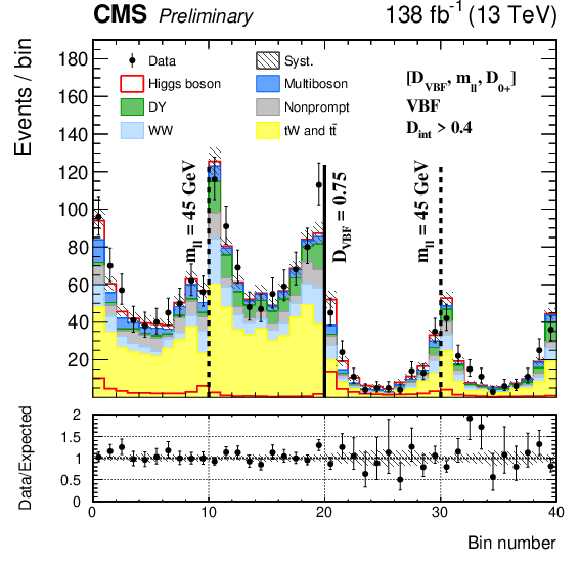
png pdf |
Figure 3-c:
Distribution of events for $ [\mathcal{D}_\text{VBF}, m_{\ell\ell}, \mathcal{D}_{0+}] $ in the VBF channel (left), and for $ [m_{\ell\ell}, \mathcal{D}_{0+}] $ in the Resolved VH (upper right) and Boosted VH (lower right) channels. For the VBF channel, the $ \mathcal{D}_{\text{int}} < $ 0.4 (upper left) and VBF $ \mathcal{D}_{\text{int}} > $ 0.4 (lower left) categories are shown. The binning strategy for each discriminant is described in Section 8.1. The predicted Higgs boson signal and background distributions are shown after the fit to the data. For the fit, the $ a_{1} $ and $ a_2 \mathrm{H}\mathrm{V}\mathrm{V} $ coupling contributions are considered. More details are given in the caption of Fig. 2. |

png pdf |
Figure 3-d:
Distribution of events for $ [\mathcal{D}_\text{VBF}, m_{\ell\ell}, \mathcal{D}_{0+}] $ in the VBF channel (left), and for $ [m_{\ell\ell}, \mathcal{D}_{0+}] $ in the Resolved VH (upper right) and Boosted VH (lower right) channels. For the VBF channel, the $ \mathcal{D}_{\text{int}} < $ 0.4 (upper left) and VBF $ \mathcal{D}_{\text{int}} > $ 0.4 (lower left) categories are shown. The binning strategy for each discriminant is described in Section 8.1. The predicted Higgs boson signal and background distributions are shown after the fit to the data. For the fit, the $ a_{1} $ and $ a_2 \mathrm{H}\mathrm{V}\mathrm{V} $ coupling contributions are considered. More details are given in the caption of Fig. 2. |

png pdf |
Figure 4:
Distribution of events for $ [\mathcal{D}_\text{VBF}, m_{\ell\ell}, \mathcal{D}_{\Lambda 1}] $ in the VBF channel (left), and for $ [m_{\ell\ell}, \mathcal{D}_{\Lambda 1}] $ in the Resolved VH (center) and Boosted VH (right) channels. The binning strategy for each discriminant is described in Section 8.1. The predicted Higgs boson signal and background distributions are shown after the fit to the data. For the fit, the $ a_{1} $ and $ \kappa_1\Lambda_1 \mathrm{H}\mathrm{V}\mathrm{V} $ coupling contributions are considered. More details are given in the caption of Fig. 2. |

png pdf |
Figure 4-a:
Distribution of events for $ [\mathcal{D}_\text{VBF}, m_{\ell\ell}, \mathcal{D}_{\Lambda 1}] $ in the VBF channel (left), and for $ [m_{\ell\ell}, \mathcal{D}_{\Lambda 1}] $ in the Resolved VH (center) and Boosted VH (right) channels. The binning strategy for each discriminant is described in Section 8.1. The predicted Higgs boson signal and background distributions are shown after the fit to the data. For the fit, the $ a_{1} $ and $ \kappa_1\Lambda_1 \mathrm{H}\mathrm{V}\mathrm{V} $ coupling contributions are considered. More details are given in the caption of Fig. 2. |

png pdf |
Figure 4-b:
Distribution of events for $ [\mathcal{D}_\text{VBF}, m_{\ell\ell}, \mathcal{D}_{\Lambda 1}] $ in the VBF channel (left), and for $ [m_{\ell\ell}, \mathcal{D}_{\Lambda 1}] $ in the Resolved VH (center) and Boosted VH (right) channels. The binning strategy for each discriminant is described in Section 8.1. The predicted Higgs boson signal and background distributions are shown after the fit to the data. For the fit, the $ a_{1} $ and $ \kappa_1\Lambda_1 \mathrm{H}\mathrm{V}\mathrm{V} $ coupling contributions are considered. More details are given in the caption of Fig. 2. |

png pdf |
Figure 4-c:
Distribution of events for $ [\mathcal{D}_\text{VBF}, m_{\ell\ell}, \mathcal{D}_{\Lambda 1}] $ in the VBF channel (left), and for $ [m_{\ell\ell}, \mathcal{D}_{\Lambda 1}] $ in the Resolved VH (center) and Boosted VH (right) channels. The binning strategy for each discriminant is described in Section 8.1. The predicted Higgs boson signal and background distributions are shown after the fit to the data. For the fit, the $ a_{1} $ and $ \kappa_1\Lambda_1 \mathrm{H}\mathrm{V}\mathrm{V} $ coupling contributions are considered. More details are given in the caption of Fig. 2. |

png pdf |
Figure 5:
Distribution of events for $ [\mathcal{D}_\text{VBF}, m_{\ell\ell}, \mathcal{D}_{\Lambda 1}^{\mathrm{Z}\gamma}] $ in the VBF channel (left), and for $ [m_{\ell\ell}, \mathcal{D}_{\Lambda 1}^{\mathrm{Z}\gamma}] $ in the Resolved VH (center) and Boosted VH (right) channels. The binning strategy for each discriminant is described in Section 8.1. The predicted Higgs boson signal and background distributions are shown after the fit to the data. For the fit, the $ a_{1} $ and $ \kappa_2^{\mathrm{Z}\gamma}\Lambda_1^{Z\gamma} \mathrm{H}\mathrm{V}\mathrm{V} $ coupling contributions are considered. More details are given in the caption of Fig. 2. |
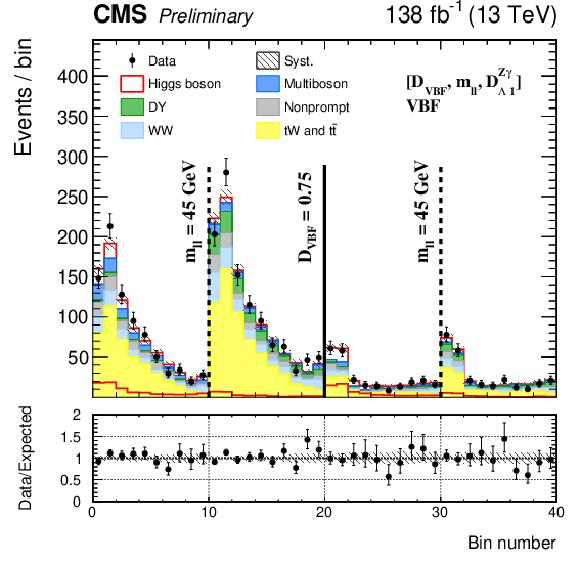
png pdf |
Figure 5-a:
Distribution of events for $ [\mathcal{D}_\text{VBF}, m_{\ell\ell}, \mathcal{D}_{\Lambda 1}^{\mathrm{Z}\gamma}] $ in the VBF channel (left), and for $ [m_{\ell\ell}, \mathcal{D}_{\Lambda 1}^{\mathrm{Z}\gamma}] $ in the Resolved VH (center) and Boosted VH (right) channels. The binning strategy for each discriminant is described in Section 8.1. The predicted Higgs boson signal and background distributions are shown after the fit to the data. For the fit, the $ a_{1} $ and $ \kappa_2^{\mathrm{Z}\gamma}\Lambda_1^{Z\gamma} \mathrm{H}\mathrm{V}\mathrm{V} $ coupling contributions are considered. More details are given in the caption of Fig. 2. |

png pdf |
Figure 5-b:
Distribution of events for $ [\mathcal{D}_\text{VBF}, m_{\ell\ell}, \mathcal{D}_{\Lambda 1}^{\mathrm{Z}\gamma}] $ in the VBF channel (left), and for $ [m_{\ell\ell}, \mathcal{D}_{\Lambda 1}^{\mathrm{Z}\gamma}] $ in the Resolved VH (center) and Boosted VH (right) channels. The binning strategy for each discriminant is described in Section 8.1. The predicted Higgs boson signal and background distributions are shown after the fit to the data. For the fit, the $ a_{1} $ and $ \kappa_2^{\mathrm{Z}\gamma}\Lambda_1^{Z\gamma} \mathrm{H}\mathrm{V}\mathrm{V} $ coupling contributions are considered. More details are given in the caption of Fig. 2. |
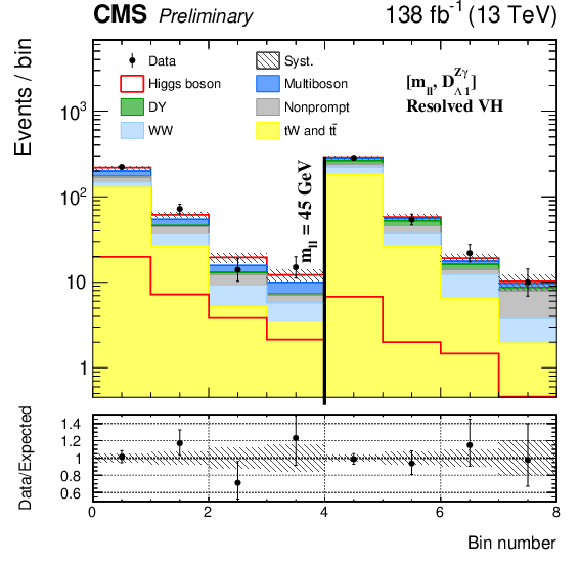
png pdf |
Figure 5-c:
Distribution of events for $ [\mathcal{D}_\text{VBF}, m_{\ell\ell}, \mathcal{D}_{\Lambda 1}^{\mathrm{Z}\gamma}] $ in the VBF channel (left), and for $ [m_{\ell\ell}, \mathcal{D}_{\Lambda 1}^{\mathrm{Z}\gamma}] $ in the Resolved VH (center) and Boosted VH (right) channels. The binning strategy for each discriminant is described in Section 8.1. The predicted Higgs boson signal and background distributions are shown after the fit to the data. For the fit, the $ a_{1} $ and $ \kappa_2^{\mathrm{Z}\gamma}\Lambda_1^{Z\gamma} \mathrm{H}\mathrm{V}\mathrm{V} $ coupling contributions are considered. More details are given in the caption of Fig. 2. |

png pdf |
Figure 6:
Distribution of events for $ [m_{\mathrm{T}}, m_{\ell\ell}] $ in the 0- (left) and 1-jet (right) $ \mathrm{g}\mathrm{g}\mathrm{H} $ channels. The binning strategy for the discriminant is described in Section 8.2. The predicted Higgs boson signal and background distributions are shown after the fit to the data. For the fit, the $ a_{1} $ and $ a_3 \mathrm{H}\mathrm{V}\mathrm{V} $ coupling contributions are considered. More details are given in the caption of Fig. 2. |

png pdf |
Figure 6-a:
Distribution of events for $ [m_{\mathrm{T}}, m_{\ell\ell}] $ in the 0- (left) and 1-jet (right) $ \mathrm{g}\mathrm{g}\mathrm{H} $ channels. The binning strategy for the discriminant is described in Section 8.2. The predicted Higgs boson signal and background distributions are shown after the fit to the data. For the fit, the $ a_{1} $ and $ a_3 \mathrm{H}\mathrm{V}\mathrm{V} $ coupling contributions are considered. More details are given in the caption of Fig. 2. |
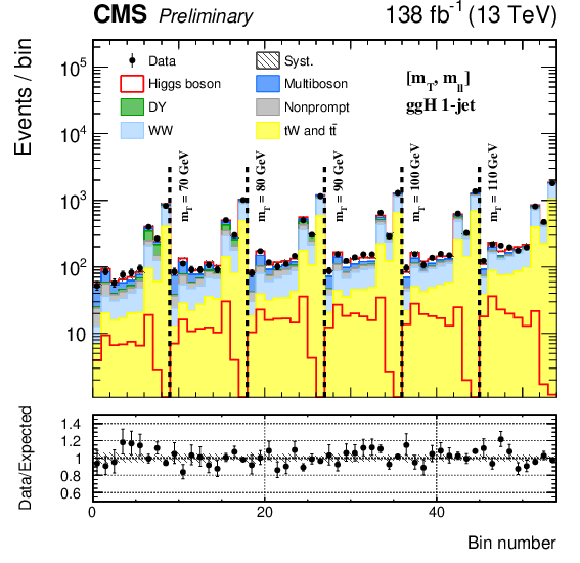
png pdf |
Figure 6-b:
Distribution of events for $ [m_{\mathrm{T}}, m_{\ell\ell}] $ in the 0- (left) and 1-jet (right) $ \mathrm{g}\mathrm{g}\mathrm{H} $ channels. The binning strategy for the discriminant is described in Section 8.2. The predicted Higgs boson signal and background distributions are shown after the fit to the data. For the fit, the $ a_{1} $ and $ a_3 \mathrm{H}\mathrm{V}\mathrm{V} $ coupling contributions are considered. More details are given in the caption of Fig. 2. |
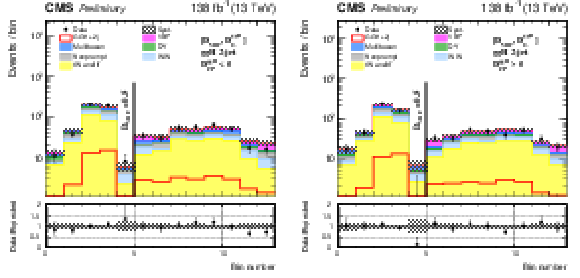
png pdf |
Figure 7:
Distributions of events for $ [\mathcal{D}_\text{VBF} $, $ \mathcal{D}^{\mathrm{g}\mathrm{g}\mathrm{H}}_{0-}] $ in the 2-jet $ \mathrm{g}\mathrm{g}\mathrm{H} $ channel. Both the $ \mathcal{D}^{\mathrm{g}\mathrm{g}\mathrm{H}}_{\text{CP}} < $ 0 (left) and $ \mathcal{D}^{\mathrm{g}\mathrm{g}\mathrm{H}}_{\text{CP}} > $ 0 (right) categories are shown. The binning strategy for the discriminant is described in Section 8.3. The predicted Higgs boson signal and background distributions are shown after the fit to the data. In this case, the VBF and $ \mathrm{g}\mathrm{g}\mathrm{H} $ signals are shown separately. For the fit, the $ a_{1} $ and $ a_3 \mathrm{H}\mathrm{g}\mathrm{g} $ coupling contributions are considered. More details are given in the caption of Fig. 2. |
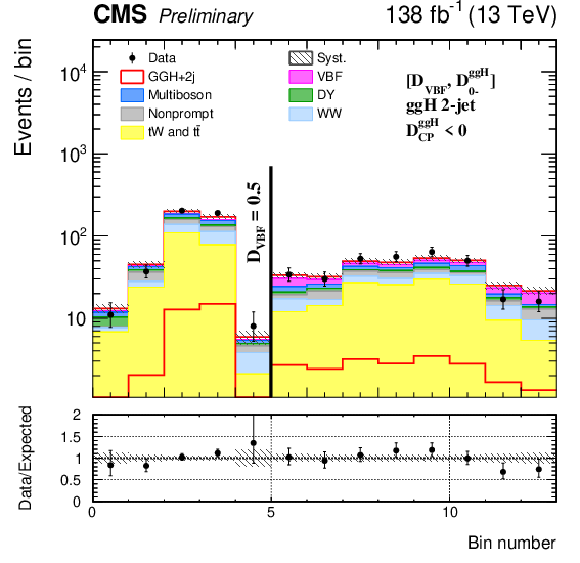
png pdf |
Figure 7-a:
Distributions of events for $ [\mathcal{D}_\text{VBF} $, $ \mathcal{D}^{\mathrm{g}\mathrm{g}\mathrm{H}}_{0-}] $ in the 2-jet $ \mathrm{g}\mathrm{g}\mathrm{H} $ channel. Both the $ \mathcal{D}^{\mathrm{g}\mathrm{g}\mathrm{H}}_{\text{CP}} < $ 0 (left) and $ \mathcal{D}^{\mathrm{g}\mathrm{g}\mathrm{H}}_{\text{CP}} > $ 0 (right) categories are shown. The binning strategy for the discriminant is described in Section 8.3. The predicted Higgs boson signal and background distributions are shown after the fit to the data. In this case, the VBF and $ \mathrm{g}\mathrm{g}\mathrm{H} $ signals are shown separately. For the fit, the $ a_{1} $ and $ a_3 \mathrm{H}\mathrm{g}\mathrm{g} $ coupling contributions are considered. More details are given in the caption of Fig. 2. |
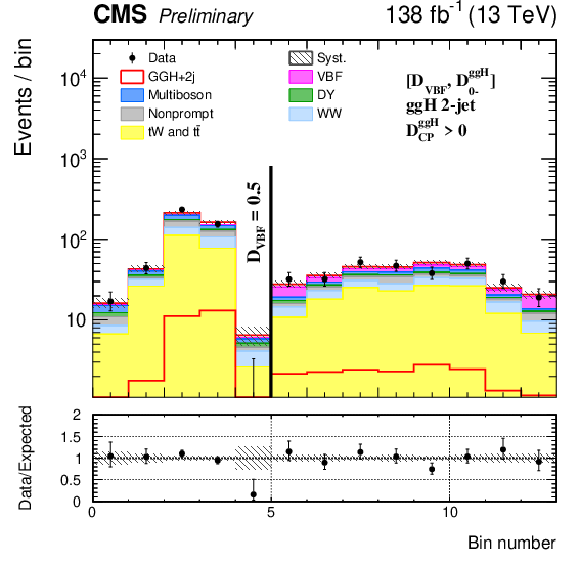
png pdf |
Figure 7-b:
Distributions of events for $ [\mathcal{D}_\text{VBF} $, $ \mathcal{D}^{\mathrm{g}\mathrm{g}\mathrm{H}}_{0-}] $ in the 2-jet $ \mathrm{g}\mathrm{g}\mathrm{H} $ channel. Both the $ \mathcal{D}^{\mathrm{g}\mathrm{g}\mathrm{H}}_{\text{CP}} < $ 0 (left) and $ \mathcal{D}^{\mathrm{g}\mathrm{g}\mathrm{H}}_{\text{CP}} > $ 0 (right) categories are shown. The binning strategy for the discriminant is described in Section 8.3. The predicted Higgs boson signal and background distributions are shown after the fit to the data. In this case, the VBF and $ \mathrm{g}\mathrm{g}\mathrm{H} $ signals are shown separately. For the fit, the $ a_{1} $ and $ a_3 \mathrm{H}\mathrm{g}\mathrm{g} $ coupling contributions are considered. More details are given in the caption of Fig. 2. |
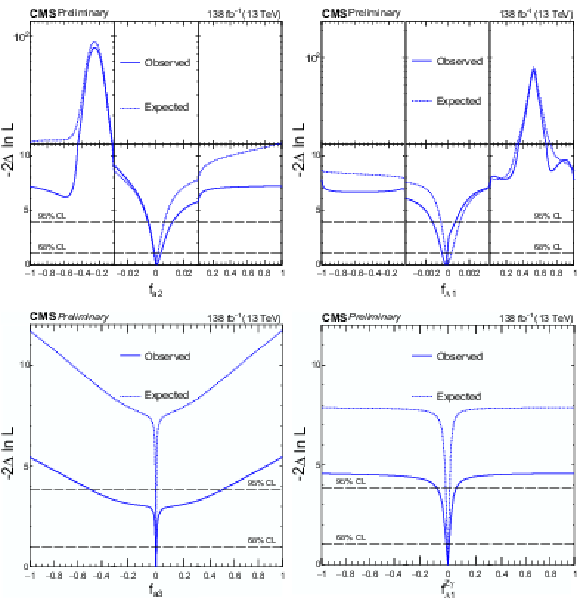
png pdf |
Figure 8:
Expected (dashed) and observed (solid) profiled likelihood on $ f_{a2} $ (upper left), $ f_{\Lambda 1} $ (upper right), $ f_{a3} $ (lower left), and $ f_{\Lambda 1}^{\mathrm{Z}\gamma} $ (lower right) using Approach 1. In each case, the signal strength modifiers are treated as free parameters. The dashed horizontal lines show the 68% and 95% CL regions. |
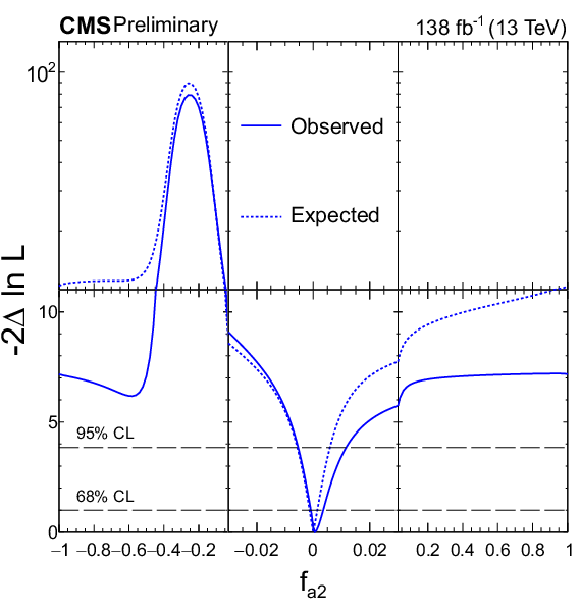
png pdf |
Figure 8-a:
Expected (dashed) and observed (solid) profiled likelihood on $ f_{a2} $ (upper left), $ f_{\Lambda 1} $ (upper right), $ f_{a3} $ (lower left), and $ f_{\Lambda 1}^{\mathrm{Z}\gamma} $ (lower right) using Approach 1. In each case, the signal strength modifiers are treated as free parameters. The dashed horizontal lines show the 68% and 95% CL regions. |

png pdf |
Figure 8-b:
Expected (dashed) and observed (solid) profiled likelihood on $ f_{a2} $ (upper left), $ f_{\Lambda 1} $ (upper right), $ f_{a3} $ (lower left), and $ f_{\Lambda 1}^{\mathrm{Z}\gamma} $ (lower right) using Approach 1. In each case, the signal strength modifiers are treated as free parameters. The dashed horizontal lines show the 68% and 95% CL regions. |
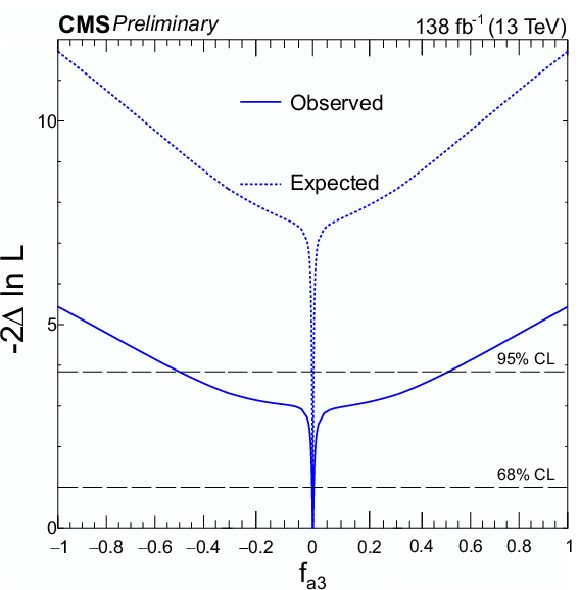
png pdf |
Figure 8-c:
Expected (dashed) and observed (solid) profiled likelihood on $ f_{a2} $ (upper left), $ f_{\Lambda 1} $ (upper right), $ f_{a3} $ (lower left), and $ f_{\Lambda 1}^{\mathrm{Z}\gamma} $ (lower right) using Approach 1. In each case, the signal strength modifiers are treated as free parameters. The dashed horizontal lines show the 68% and 95% CL regions. |
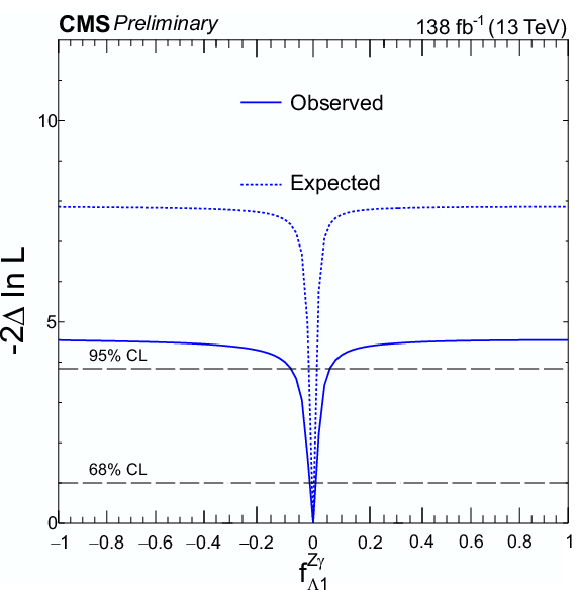
png pdf |
Figure 8-d:
Expected (dashed) and observed (solid) profiled likelihood on $ f_{a2} $ (upper left), $ f_{\Lambda 1} $ (upper right), $ f_{a3} $ (lower left), and $ f_{\Lambda 1}^{\mathrm{Z}\gamma} $ (lower right) using Approach 1. In each case, the signal strength modifiers are treated as free parameters. The dashed horizontal lines show the 68% and 95% CL regions. |
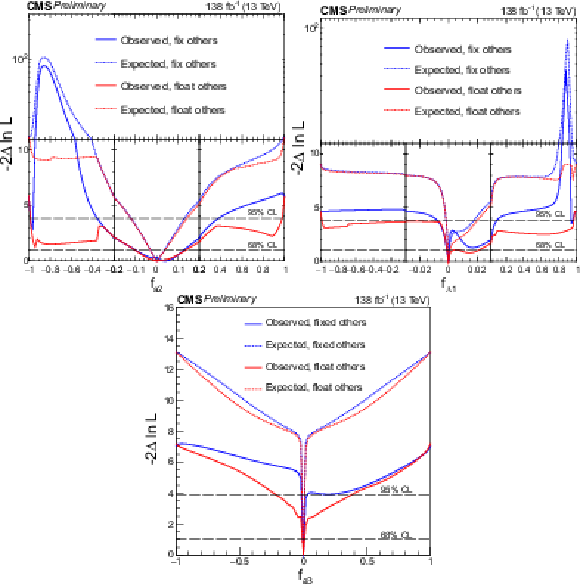
png pdf |
Figure 9:
Expected (dashed) and observed (solid) profiled likelihood on $ f_{a2} $ (upper left), $ f_{\Lambda 1} $ (upper right) and $ f_{a3} $ (bottom) using Approach 2. The other two anomalous coupling cross section fractions are either fixed to zero (blue) or left floating in the fit (red). In each case, the signal strength modifiers are treated as free parameters. The dashed horizontal lines show the 68% and 95% CL regions. |
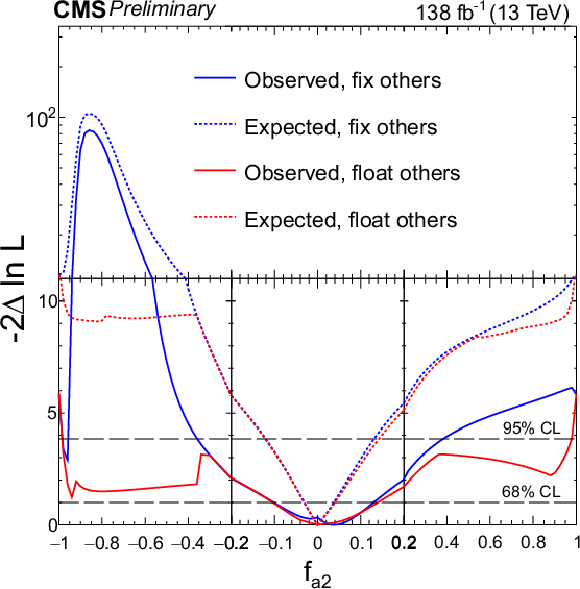
png pdf |
Figure 9-a:
Expected (dashed) and observed (solid) profiled likelihood on $ f_{a2} $ (upper left), $ f_{\Lambda 1} $ (upper right) and $ f_{a3} $ (bottom) using Approach 2. The other two anomalous coupling cross section fractions are either fixed to zero (blue) or left floating in the fit (red). In each case, the signal strength modifiers are treated as free parameters. The dashed horizontal lines show the 68% and 95% CL regions. |

png pdf |
Figure 9-b:
Expected (dashed) and observed (solid) profiled likelihood on $ f_{a2} $ (upper left), $ f_{\Lambda 1} $ (upper right) and $ f_{a3} $ (bottom) using Approach 2. The other two anomalous coupling cross section fractions are either fixed to zero (blue) or left floating in the fit (red). In each case, the signal strength modifiers are treated as free parameters. The dashed horizontal lines show the 68% and 95% CL regions. |

png pdf |
Figure 9-c:
Expected (dashed) and observed (solid) profiled likelihood on $ f_{a2} $ (upper left), $ f_{\Lambda 1} $ (upper right) and $ f_{a3} $ (bottom) using Approach 2. The other two anomalous coupling cross section fractions are either fixed to zero (blue) or left floating in the fit (red). In each case, the signal strength modifiers are treated as free parameters. The dashed horizontal lines show the 68% and 95% CL regions. |
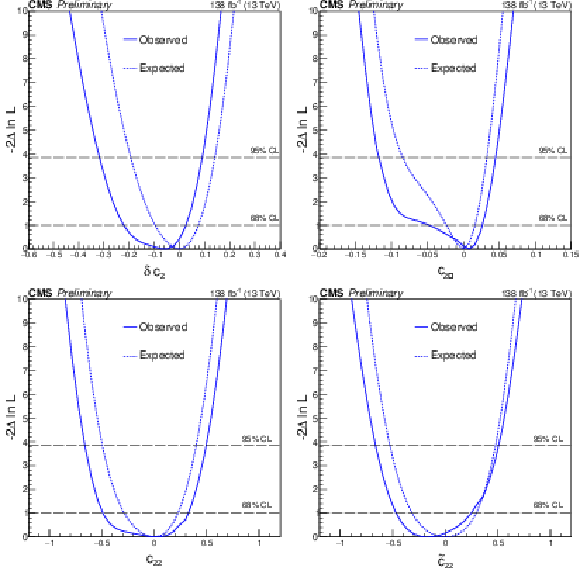
png pdf |
Figure 10:
Expected (dashed) and observed (solid) profiled likelihood on the $ \delta c_\text{z} $ (upper left), $ c_{\text{z}\Box} $ (upper right), $ c_\text{zz} $ (lower left) and $ \tilde{c}_\text{zz} $ (lower right) couplings of the SMEFT Higgs basis. All four couplings are studied simultaneously. The dashed horizontal lines show the 68% and 95% CL regions. |
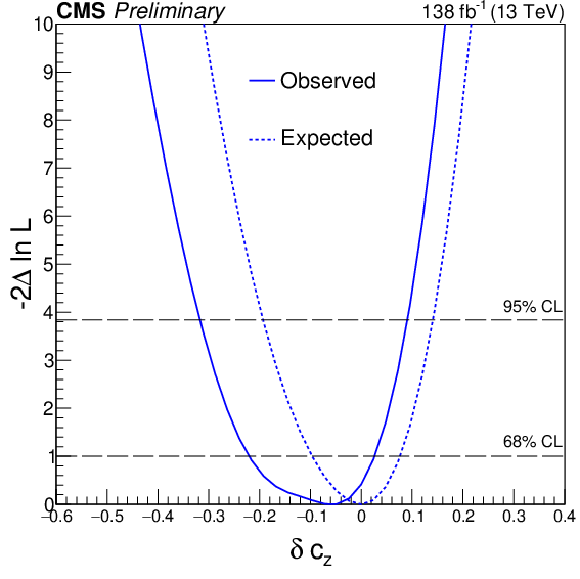
png pdf |
Figure 10-a:
Expected (dashed) and observed (solid) profiled likelihood on the $ \delta c_\text{z} $ (upper left), $ c_{\text{z}\Box} $ (upper right), $ c_\text{zz} $ (lower left) and $ \tilde{c}_\text{zz} $ (lower right) couplings of the SMEFT Higgs basis. All four couplings are studied simultaneously. The dashed horizontal lines show the 68% and 95% CL regions. |
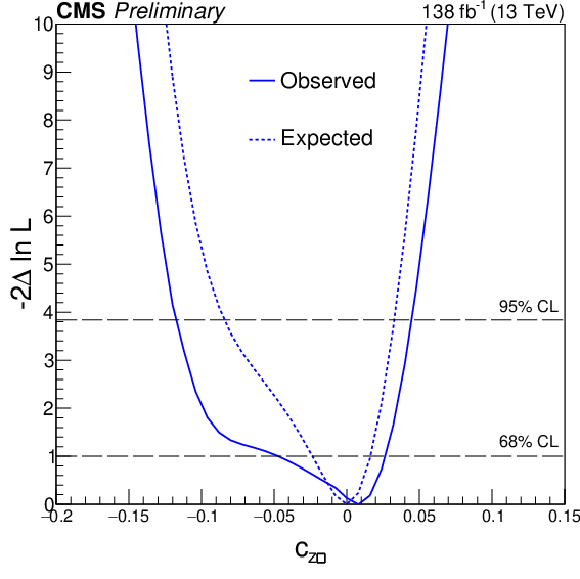
png pdf |
Figure 10-b:
Expected (dashed) and observed (solid) profiled likelihood on the $ \delta c_\text{z} $ (upper left), $ c_{\text{z}\Box} $ (upper right), $ c_\text{zz} $ (lower left) and $ \tilde{c}_\text{zz} $ (lower right) couplings of the SMEFT Higgs basis. All four couplings are studied simultaneously. The dashed horizontal lines show the 68% and 95% CL regions. |

png pdf |
Figure 10-c:
Expected (dashed) and observed (solid) profiled likelihood on the $ \delta c_\text{z} $ (upper left), $ c_{\text{z}\Box} $ (upper right), $ c_\text{zz} $ (lower left) and $ \tilde{c}_\text{zz} $ (lower right) couplings of the SMEFT Higgs basis. All four couplings are studied simultaneously. The dashed horizontal lines show the 68% and 95% CL regions. |

png pdf |
Figure 10-d:
Expected (dashed) and observed (solid) profiled likelihood on the $ \delta c_\text{z} $ (upper left), $ c_{\text{z}\Box} $ (upper right), $ c_\text{zz} $ (lower left) and $ \tilde{c}_\text{zz} $ (lower right) couplings of the SMEFT Higgs basis. All four couplings are studied simultaneously. The dashed horizontal lines show the 68% and 95% CL regions. |

png pdf |
Figure 11:
Expected (dashed) and observed (solid) profiled likelihood on $ f_{a3}^{\mathrm{g}\mathrm{g}\mathrm{H}} $. The signal strength modifiers and the CP-odd $ \mathrm{H}\mathrm{V}\mathrm{V} $ anomalous coupling cross section fraction are treated as free parameters. The crossing of the observed likelihood with the dashed horizontal line shows the observed 68% CL region. |
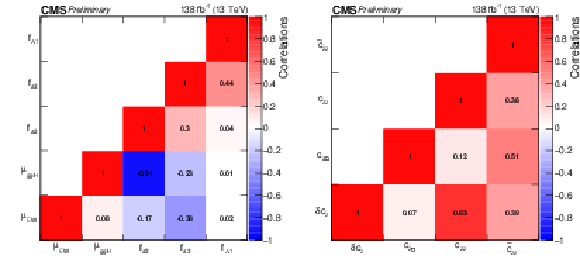
png pdf |
Figure 12:
The observed correlation coefficients between $ \mathrm{H}\mathrm{V}\mathrm{V} $ anomalous coupling cross section fractions and signal strength modifiers (left) and between SMEFT Higgs basis coupling parameters (right). |
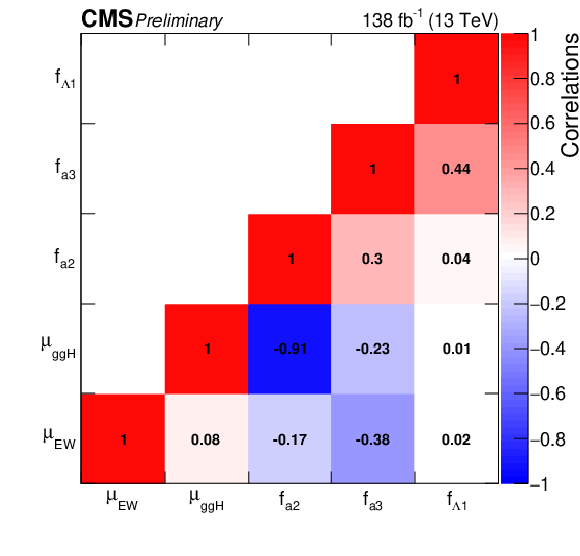
png pdf |
Figure 12-a:
The observed correlation coefficients between $ \mathrm{H}\mathrm{V}\mathrm{V} $ anomalous coupling cross section fractions and signal strength modifiers (left) and between SMEFT Higgs basis coupling parameters (right). |

png pdf |
Figure 12-b:
The observed correlation coefficients between $ \mathrm{H}\mathrm{V}\mathrm{V} $ anomalous coupling cross section fractions and signal strength modifiers (left) and between SMEFT Higgs basis coupling parameters (right). |
| Tables | |

png pdf |
Table 1:
The cross sections for the anomalous contributions ($ \sigma_i $) relative to the SM value ($ \sigma_1 $) used to define the fractional cross sections $ f_{ai} $. In the case of the $ \kappa_{1} $ and $ \kappa_{2}^{\mathrm{Z}\gamma} $ couplings, the numerical values $ \Lambda_1 = \Lambda_1^{\mathrm{Z}\gamma} = $ 100 GeV are considered so as to keep all coefficients of similar order of magnitude. Two sets of values corresponding to the $ a_{i}^{\mathrm{Z}\mathrm{Z}} = a_{i}^{\mathrm{W}\mathrm{W}} $ (Approach 1) and SU(2) x U(1) (Approach 2) coupling relationships are shown. |
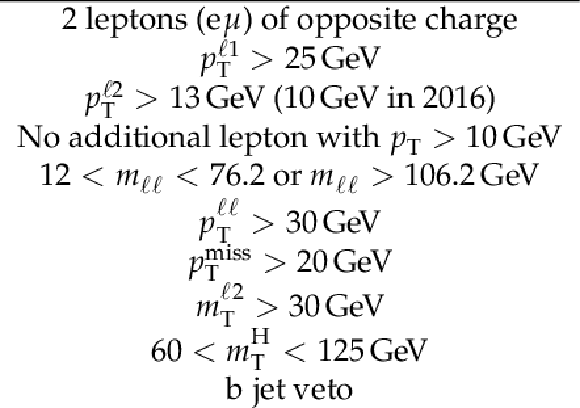
png pdf |
Table 2:
Summary of the base selection criteria. |

png pdf |
Table 3:
Summary of the $ \mathrm{g}\mathrm{g}\mathrm{H} $, VBF, and VH channel selections used for the $ \mathrm{H}\mathrm{V}\mathrm{V} $ coupling study. |

png pdf |
Table 4:
Summary of $ \mathrm{g}\mathrm{g}\mathrm{H} $ channel selections used for the $ \mathrm{H}\mathrm{g}\mathrm{g} $ coupling study. |

png pdf |
Table 5:
Summary of the $ \tau\tau $, top quark, and WW control region requirements. |

png pdf |
Table 6:
The kinematic observables used for the interference based categorization and for the final discriminants used in the fits to data to study the $ \mathrm{H}\mathrm{V}\mathrm{V} $ and $ \mathrm{H}\mathrm{g}\mathrm{g} $ couplings. For each of the anomalous $ \mathrm{H}\mathrm{V}\mathrm{V} $ couplings in Approach 1, we have a dedicated analysis in the VBF and VH channels. In Approach 2, we use one analysis to target all anomalous $ \mathrm{H}\mathrm{V}\mathrm{V} $ couplings simultaneously. |
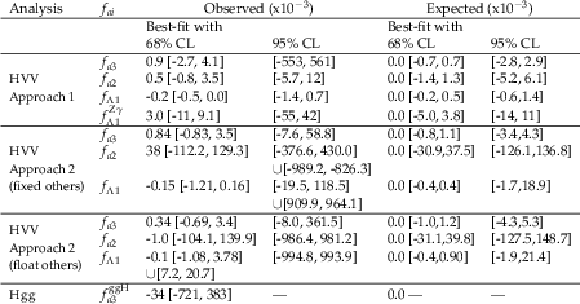
png pdf |
Table 7:
Summary of constraints on the anomalous $ \mathrm{H}\mathrm{V}\mathrm{V} $ and $ \mathrm{H}\mathrm{g}\mathrm{g} $ coupling parameters with the best-fit values and allowed 68% and 95 $ % \text{CL} $ (in square brackets) intervals. For Approach 1, each $ f_{ai} $ is studied independently. For Approach 2, each $ f_{ai} $ is shown separately with the other two cross section fractions either fixed to zero or left floating in the fit. In each case, the signal strength modifiers are treated as free parameters. |

png pdf |
Table 8:
Summary of expected and observed constraints on the SMEFT Higgs basis coupling parameters. |
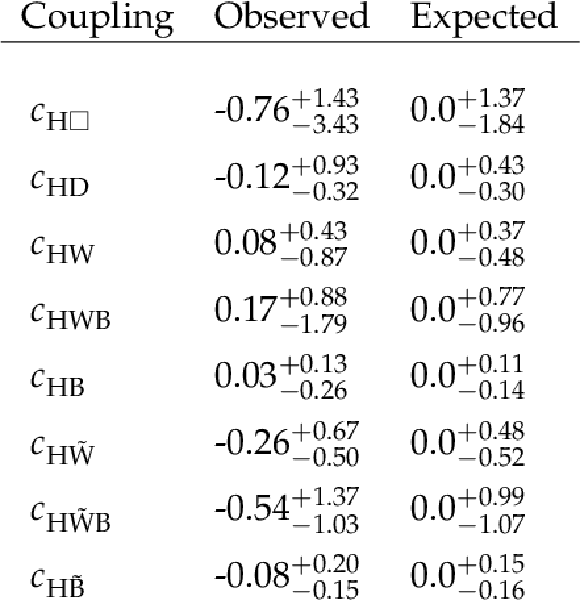
png pdf |
Table 9:
Summary of expected and observed constraints on the SMEFT Warsaw basis coupling parameters. |
| Summary |
| This note presents a study of the anomalous couplings of the Higgs boson (H) with vector bosons, including CP violation effects, using its associated production with hadronic jets in gluon fusion, vector boson fusion, and associated production with a W or Z boson, and its subsequent decay to a pair of W bosons. The results are based on the proton-proton collision data set collected by the CMS detector at the LHC during 2016-2018, corresponding to an integrated luminosity of 138 fb$ ^{-1} $ at a center-of-mass energy of 13 TeV. The analysis targets the different-flavor dilepton (e$\mu $) final state, with kinematic information from associated jets combined using matrix element techniques to increase sensitivity to anomalous effects at the production vertex. Dedicated Monte Carlo simulation and matrix-element reweighting provide modeling of all kinematic features in the production and decay of the Higgs boson with full simulation of detector effects. A simultaneous measurement of four Higgs boson couplings to electroweak vector bosons has been performed in the framework of a standard model effective field theory. All measurements are consistent with the expectations for the standard model Higgs boson and constraints are set on the fractional contribution of the anomalous couplings to the Higgs boson cross section. These results significantly surpass that of the previous $ \mathrm{H}\to\mathrm{W}\mathrm{W} $ anomalous coupling analysis from the CMS experiment in both precision and coverage. |
| References | ||||
| 1 | ATLAS Collaboration | Observation of a new particle in the search for the standard model Higgs boson with the ATLAS detector at the LHC | PLB 716 (2012) 1 | 1207.7214 |
| 2 | CMS Collaboration | Observation of a new boson at a mass of 125 GeV with the CMS experiment at the LHC | PLB 716 (2012) 30 | CMS-HIG-12-028 1207.7235 |
| 3 | CMS Collaboration | Observation of a new boson with mass near 125 GeV in pp collisions at $ \sqrt{s}= $ 7 and 8 TeV | JHEP 06 (2013) 081 | CMS-HIG-12-036 1303.4571 |
| 4 | CMS Collaboration | On the mass and spin-parity of the Higgs boson candidate via its decays to Z boson pairs | PRL 110 (2013) 081803 | CMS-HIG-12-041 1212.6639 |
| 5 | CMS Collaboration | Measurement of the properties of a Higgs boson in the four-lepton final state | PRD 89 (2014) 092007 | CMS-HIG-13-002 1312.5353 |
| 6 | CMS Collaboration | Constraints on the spin-parity and anomalous HVV couplings of the Higgs boson in proton collisions at 7 and 8 TeV | PRD 92 (2015) 012004 | CMS-HIG-14-018 1411.3441 |
| 7 | CMS Collaboration | Limits on the Higgs boson lifetime and width from its decay to four charged leptons | PRD 92 (2015) 072010 | CMS-HIG-14-036 1507.06656 |
| 8 | CMS Collaboration | Combined search for anomalous pseudoscalar HVV couplings in VH production and $ \mathrm{H}\to \mathrm{V}\mathrm{V} $ decay | PLB 759 (2016) 672 | CMS-HIG-14-035 1602.04305 |
| 9 | CMS Collaboration | Constraints on anomalous Higgs boson couplings using production and decay information in the four-lepton final state | PLB 775 (2017) 1 | CMS-HIG-17-011 1707.00541 |
| 10 | CMS Collaboration | Measurements of the Higgs boson width and anomalous HVV couplings from on-shell and off-shell production in the four-lepton final state | PRD 99 (2019) 112003 | CMS-HIG-18-002 1901.00174 |
| 11 | CMS Collaboration | Constraints on anomalous $ \mathrm{H}\mathrm{V}\mathrm{V} $ couplings from the production of Higgs bosons decaying to $ \tau $ lepton pairs | PRD 100 (2019) 112002 | CMS-HIG-17-034 1903.06973 |
| 12 | ATLAS Collaboration | Evidence for the spin-0 nature of the Higgs boson using ATLAS data | PLB 726 (2013) 120 | 1307.1432 |
| 13 | ATLAS Collaboration | Study of the spin and parity of the Higgs boson in diboson decays with the ATLAS detector | EPJC 75 (2015) 476 | 1506.05669 |
| 14 | ATLAS Collaboration | Test of $ CP $ invariance in vector-boson fusion production of the Higgs boson using the Optimal Observable method in the ditau decay channel with the ATLAS detector | EPJC 76 (2016) 658 | 1602.04516 |
| 15 | ATLAS Collaboration | Measurement of inclusive and differential cross sections in the $ \mathrm{H} \rightarrow \mathrm{Z}\mathrm{Z}^{*} \rightarrow 4\ell $ decay channel in pp collisions at $ \sqrt{s}= $ 13 TeV with the ATLAS detector | JHEP 10 (2017) 132 | 1708.02810 |
| 16 | ATLAS Collaboration | Measurement of the Higgs boson coupling properties in the $ \mathrm{H} \rightarrow \mathrm{Z}\mathrm{Z}^{*} \rightarrow 4\ell $ decay channel at $ \sqrt{s} $ = 13 TeV with the ATLAS detector | JHEP 03 (2018) 095 | 1712.02304 |
| 17 | ATLAS Collaboration | Measurements of Higgs boson properties in the diphoton decay channel with 36 fb$ ^{-1} $ of pp collision data at $ \sqrt{s} = $ 13 TeV with the ATLAS detector | PRD 98 (2018) 052005 | 1802.04146 |
| 18 | ATLAS Collaboration | Test of $ CP $ invariance in vector-boson fusion production of the Higgs boson in the $ \mathrm {H}\rightarrow\tau\tau $ channel in proton-proton collisions at $ \sqrt{s} $ = 13 TeV with the ATLAS detector | PLB 805 (2020) 135426 | 2002.05315 |
| 19 | LHC Higgs Cross Section Working Group | Handbook of LHC Higgs cross sections: 4. Deciphering the nature of the Higgs sector | CERN Report CERN-2017-002-M, 2016 link |
1610.07922 |
| 20 | Y. Gao et al. | Spin determination of single-produced resonances at hadron colliders | PRD 81 (2010) 075022 | 1001.3396 |
| 21 | S. Bolognesi et al. | On the spin and parity of a single-produced resonance at the LHC | PRD 86 (2012) 095031 | 1208.4018 |
| 22 | I. Anderson et al. | Constraining anomalous HVV interactions at proton and lepton colliders | PRD 89 (2014) 035007 | 1309.4819 |
| 23 | A. V. Gritsan, R. Röntsch, M. Schulze, and M. Xiao | Constraining anomalous Higgs boson couplings to the heavy flavor fermions using matrix element techniques | PRD 94 (2016) 055023 | 1606.03107 |
| 24 | A. V. Gritsan et al. | New features in the JHU generator framework: constraining Higgs boson properties from on-shell and off-shell production | PRD 102 (2020) 056022 | 2002.09888 |
| 25 | CMS Collaboration | Measurements of the Higgs boson production cross section and couplings in the W boson pair decay channel in proton-proton collisions at $ \sqrt{s} $ = 13 TeV | Submitted to EPJC, 2022 | CMS-HIG-20-013 2206.09466 |
| 26 | LHC Higgs Cross Section Working Group | Handbook of LHC Higgs Cross Sections: 3. Higgs Properties: Report of the LHC Higgs Cross Section Working Group | CERN Report CERN-2013-004, 2013 link |
1307.1347 |
| 27 | CMS Collaboration | Measurements of $ {\mathrm{t}\overline{\mathrm{t}}} \mathrm{H} $ production and the $ CP $ structure of the Yukawa interaction between the Higgs boson and top quark in the diphoton decay channel | PRL 125 (2020) 061801 | CMS-HIG-19-013 2003.10866 |
| 28 | CMS Collaboration | Constraints on anomalous Higgs boson couplings using production and decay information in the four-lepton final state | PLB 775 (2017) | |
| 29 | CMS Collaboration | Constraints on anomalous Higgs boson couplings to vector bosons and fermions in its production and decay using the four-lepton final state | PRD 104 (2021) | |
| 30 | I. Anderson et al. | Constraining anomalous $ \mathrm{H}\mathrm{V}\mathrm{V} $ interactions at proton and lepton colliders | PRD 89 (2014) 035007 | |
| 31 | J. Davis et al. | Constraining anomalous Higgs boson couplings to virtual photons | PRD 105 (2022) 096027 | 2109.13363 |
| 32 | CMS Collaboration | The CMS experiment at the CERN LHC | JINST 3 (2008) S08004 | |
| 33 | CMS Collaboration | Performance of the CMS Level-1 trigger in proton-proton collisions at $ \sqrt{s} = $ 13\,TeV | JINST 15 (2020) P10017 | CMS-TRG-17-001 2006.10165 |
| 34 | CMS Collaboration | The CMS trigger system | JINST 12 (2017) P01020 | CMS-TRG-12-001 1609.02366 |
| 35 | CMS Collaboration | Performance of electron reconstruction and selection with the CMS detector in proton-proton collisions at $ \sqrt{s} = $ 8 TeV | JINST 10 (2015) P06005 | CMS-EGM-13-001 1502.02701 |
| 36 | CMS Collaboration | Performance of the CMS muon detector and muon reconstruction with proton-proton collisions at $ \sqrt{s}= $ 13 TeV | JINST 13 (2018) P06015 | CMS-MUO-16-001 1804.04528 |
| 37 | CMS Collaboration | Performance of photon reconstruction and identification with the CMS detector in proton-proton collisions at sqrt(s) = 8 TeV | JINST 10 (2015) P08010 | CMS-EGM-14-001 1502.02702 |
| 38 | CMS Collaboration | Description and performance of track and primary-vertex reconstruction with the CMS tracker | JINST 9 (2014) P10009 | CMS-TRK-11-001 1405.6569 |
| 39 | CMS Collaboration | Particle-flow reconstruction and global event description with the CMS detector | JINST 12 (2017) P10003 | CMS-PRF-14-001 1706.04965 |
| 40 | CMS Collaboration | Performance of reconstruction and identification of $ \tau $ leptons decaying to hadrons and $ \nu_\tau $ in pp collisions at $ \sqrt{s}= $ 13 TeV | JINST 13 (2018) P10005 | CMS-TAU-16-003 1809.02816 |
| 41 | CMS Collaboration | Jet energy scale and resolution in the CMS experiment in pp collisions at 8 TeV | JINST 12 (2017) P02014 | CMS-JME-13-004 1607.03663 |
| 42 | CMS Collaboration | Performance of missing transverse momentum reconstruction in proton-proton collisions at $ \sqrt{s} = $ 13\,TeV using the CMS detector | JINST 14 (2019) P07004 | CMS-JME-17-001 1903.06078 |
| 43 | CMS Collaboration | Performance of the CMS Level-1 trigger in proton-proton collisions at $ \sqrt{s} = $ 13\,TeV | JINST 15 (2020) P10017 | CMS-TRG-17-001 2006.10165 |
| 44 | CMS Collaboration | Precision luminosity measurement in proton-proton collisions at $ \sqrt{s} = $ 13 TeV in 2015 and 2016 at CMS | EPJC 81 (2021) 800 | CMS-LUM-17-003 2104.01927 |
| 45 | CMS Collaboration | CMS luminosity measurement for the 2017 data-taking period at $ \sqrt{s} = $ 13 TeV | CMS Physics Analysis Summary, 2017 CMS-PAS-LUM-17-004 |
CMS-PAS-LUM-17-004 |
| 46 | CMS Collaboration | CMS luminosity measurement for the 2018 data-taking period at $ \sqrt{s} = $ 13 TeV | CMS Physics Analysis Summary, 2019 CMS-PAS-LUM-18-002 |
CMS-PAS-LUM-18-002 |
| 47 | NNPDF Collaboration | Parton distributions with QED corrections | NPB 877 (2013) 290 | 1308.0598 |
| 48 | NNPDF Collaboration | Unbiased global determination of parton distributions and their uncertainties at NNLO and at LO | NPB 855 (2012) 153 | 1107.2652 |
| 49 | NNPDF Collaboration | Parton distributions from high-precision collider data | EPJC 77 (2017) 663 | 1706.00428 |
| 50 | CMS Collaboration | Event generator tunes obtained from underlying event and multiparton scattering measurements | EPJC 76 (2016) 155 | CMS-GEN-14-001 1512.00815 |
| 51 | CMS Collaboration | Extraction and validation of a new set of CMS \textscPYTHIA8 tunes from underlying-event measurements | EPJC 80 (2020) 4 | CMS-GEN-17-001 1903.12179 |
| 52 | T. Sjöstrand et al. | An introduction to PYTHIA 8.2 | Comput. Phys. Commun. 191 (2015) 159 | 1410.3012 |
| 53 | P. Nason | A new method for combining NLO QCD with shower Monte Carlo algorithms | JHEP 11 (2004) 040 | hep-ph/0409146 |
| 54 | S. Frixione, P. Nason, and C. Oleari | Matching NLO QCD computations with parton shower simulations: the POWHEG method | JHEP 11 (2007) 070 | 0709.2092 |
| 55 | S. Alioli, P. Nason, C. Oleari, and E. Re | A general framework for implementing NLO calculations in shower Monte Carlo programs: the POWHEG BOX | JHEP 06 (2010) 043 | 1002.2581 |
| 56 | E. Bagnaschi, G. Degrassi, P. Slavich, and A. Vicini | Higgs production via gluon fusion in the POWHEG approach in the SM and in the MSSM | JHEP 02 (2012) 088 | 1111.2854 |
| 57 | P. Nason and C. Oleari | NLO Higgs boson production via vector-boson fusion matched with shower in POWHEG | JHEP 02 (2010) 037 | 0911.5299 |
| 58 | G. Luisoni, P. Nason, C. Oleari, and F. Tramontano | HW$^{\pm} $/HZ + 0 and 1 jet at NLO with the POWHEG BOX interfaced to GoSam and their merging within MiNLO | JHEP 10 (2013) 083 | 1306.2542 |
| 59 | H. B. Hartanto, B. Jager, L. Reina, and D. Wackeroth | Higgs boson production in association with top quarks in the POWHEG BOX | PRD 91 (2015) 094003 | 1501.04498 |
| 60 | K. Hamilton, P. Nason, E. Re, and G. Zanderighi | NNLOPS simulation of Higgs boson production | JHEP 10 (2013) 222 | 1309.0017 |
| 61 | K. Hamilton, P. Nason, and G. Zanderighi | Finite quark-mass effects in the NNLOPS POWHEG+MiNLO Higgs generator | JHEP 05 (2015) 140 | 1501.04637 |
| 62 | R. Frederix and K. Hamilton | Extending the MINLO method | JHEP 05 (2016) 042 | 1512.02663 |
| 63 | J. Alwall et al. | The automated computation of tree-level and next-to-leading order differential cross sections, and their matching to parton shower simulations | JHEP 07 (2014) 079 | 1405.0301 |
| 64 | P. Nason, C. Oleari, M. Rocco, and M. Zaro | An interface between the powheg box and MadGraph5\_aMC@NLO | EPJC 80 (2020) 10 | 2008.06364 |
| 65 | P. Nason and G. Zanderighi | $ W^+ W^- $, $ W Z $ and $ Z Z $ production in the POWHEG-BOX-V2 | EPJC 74 (2014) 2702 | 1311.1365 |
| 66 | J. M. Campbell and R. K. Ellis | An update on vector boson pair production at hadron colliders | PRD 60 (1999) 113006 | hep-ph/9905386 |
| 67 | J. M. Campbell, R. K. Ellis, and C. Williams | Vector boson pair production at the LHC | JHEP 07 (2011) 018 | 1105.0020 |
| 68 | J. M. Campbell, R. K. Ellis, and W. T. Giele | A multi-threaded version of MCFM | EPJC 75 (2015) 246 | 1503.06182 |
| 69 | F. Caola et al. | QCD corrections to vector boson pair production in gluon fusion including interference effects with off-shell Higgs at the LHC | JHEP 07 (2016) 087 | 1605.04610 |
| 70 | J. Alwall et al. | Comparative study of various algorithms for the merging of parton showers and matrix elements in hadronic collisions | EPJC 53 (2008) 473 | 0706.2569 |
| 71 | S. Frixione, P. Nason, and G. Ridolfi | A positive-weight next-to-leading-order Monte Carlo for heavy flavour hadroproduction | JHEP 09 (2007) 126 | 0707.3088 |
| 72 | S. Alioli, P. Nason, C. Oleari, and E. Re | NLO single-top production matched with shower in POWHEG: $ s $- and $ t $-channel contributions | JHEP 09 (2009) 111 | 0907.4076 |
| 73 | E. Re | Single-top Wt-channel production matched with parton showers using the POWHEG method | EPJC 71 (2011) 1547 | 1009.2450 |
| 74 | R. Frederix and S. Frixione | Merging meets matching in MC@NLO | JHEP 12 (2012) 061 | 1209.6215 |
| 75 | GEANT4 Collaboration | GEANT 4 --a simulation toolkit | NIM A 506 (2003) 250 | |
| 76 | CMS Collaboration | Measurement of the Higgs boson production rate in association with top quarks in final states with electrons, muons, and hadronically decaying tau leptons at $ \sqrt{s} = $ 13 TeV | EPJC 81 (2021) 378 | CMS-HIG-19-008 2011.03652 |
| 77 | W. Waltenberger, R. Frühwirth, and P. Vanlaer | Adaptive vertex fitting | JPG 34 (2007) N343 | |
| 78 | M. Cacciari, G. P. Salam, and G. Soyez | The anti-$ k_{\mathrm{T}} $ jet clustering algorithm | JHEP 04 (2008) 063 | 0802.1189 |
| 79 | M. Cacciari, G. P. Salam, and G. Soyez | FastJet user manual | EPJC 72 (2012) 1896 | 1111.6097 |
| 80 | CMS Collaboration | Pileup mitigation at CMS in 13 TeV data | JINST 15 (2020) P09018 | CMS-JME-18-001 2003.00503 |
| 81 | D. Bertolini, P. Harris, M. Low, and N. Tran | Pileup Per Particle Identification | JHEP 10 (2014) 059 | 1407.6013 |
| 82 | J. Thaler and K. Van Tilburg | Identifying boosted objects with $ N $-subjettiness | JHEP 03 (2011) 015 | 1011.2268 |
| 83 | M. Dasgupta, A. Fregoso, S. Marzani, and G. P. Salam | Towards an understanding of jet substructure | JHEP 09 (2013) 029 | 1307.0007 |
| 84 | J. M. Butterworth, A. R. Davison, M. Rubin, and G. P. Salam | Jet substructure as a new Higgs search channel at the LHC | PRL 100 (2008) 242001 | 0802.2470 |
| 85 | A. J. Larkoski, S. Marzani, G. Soyez, and J. Thaler | Soft Drop | JHEP 05 (2014) 146 | 1402.2657 |
| 86 | CMS Collaboration | Identification of heavy-flavour jets with the CMS detector in pp collisions at 13 TeV | JINST 13 (2018) P05011 | CMS-BTV-16-002 1712.07158 |
| 87 | CMS Collaboration | CMS Phase 1 heavy flavour identification performance and developments | CMS Detector Performance Summary CMS-DP-2020-019, 2017 CDS |
|
| 88 | CMS Collaboration | Performance of missing transverse momentum reconstruction in proton-proton collisions at $ \sqrt{s} = $ 13\,TeV using the CMS detector | JINST 14 (2019) P07004 | CMS-JME-17-001 1903.06078 |
| 89 | CMS Collaboration | Measurements of properties of the Higgs boson decaying to a W boson pair in pp collisions at $ \sqrt{s}= $ 13 TeV | PLB 791 (2019) 96 | CMS-HIG-16-042 1806.05246 |
| 90 | CMS Collaboration | Measurements of inclusive W and Z cross sections in pp collisions at $ \sqrt{s}= $ 7 TeV | JHEP 01 (2011) 080 | CMS-EWK-10-002 1012.2466 |
| 91 | M. Czakon et al. | Top-pair production at the LHC through NNLO QCD and NLO EW | JHEP 10 (2017) 186 | 1705.04105 |
| 92 | P. Meade, H. Ramani, and M. Zeng | Transverse momentum resummation effects in $ \mathrm{W}^+\mathrm{W}^- $ measurements | PRD 90 (2014) 114006 | 1407.4481 |
| 93 | P. Jaiswal and T. Okui | Explanation of the $ \mathrm{W}\mathrm{W} $ excess at the LHC by jet-veto resummation | PRD 90 (2014) 073009 | 1407.4537 |
| 94 | CMS Collaboration | An embedding technique to determine $ \tau\tau $ backgrounds in proton-proton collision data | JINST 14 (2019) P06032 | CMS-TAU-18-001 1903.01216 |
| 95 | CMS Collaboration | Precision luminosity measurement in proton-proton collisions at $ \sqrt{s}= $ 13 TeV in 2015 and 2016 at CMS | EPJC 800 (2021) 81 | CMS-LUM-17-003 2104.01927 |
| 96 | CMS Collaboration | Identification techniques for highly boosted W bosons that decay into hadrons | JHEP 12 (2014) 017 | CMS-JME-13-006 1410.4227 |
| 97 | CMS Collaboration | Measurements of properties of the Higgs boson decaying to a W boson pair in pp collisions at $ \sqrt{s}= $ 13 TeV | PLB 791 (2019) 96 | CMS-HIG-16-042 1806.05246 |
| 98 | ATLAS Collaboration | Measurement of the inelastic proton-proton cross section at $ \sqrt{s}=13\text{ }\text{ }\mathrm{TeV} $ with the ATLAS detector at the LHC | PRL 117 (2016) 182002 | |
| 99 | CMS Collaboration | Measurement of the inelastic proton-proton cross section at $ \sqrt{s}= $ 13 TeV | JHEP 07 (2018) 161 | CMS-FSQ-15-005 1802.02613 |
| 100 | G. Passarino | Higgs CAT | EPJC 74 (2014) 2866 | |
| 101 | ATLAS and CMS Collaborations, LHC Higgs Combination Group | Procedure for the LHC Higgs boson search combination in Summer 2011 | Technical Report ATL-PHYS-PUB 2011-11, CMS NOTE 2011/005, 2011 link |
|
| 102 | A. V. Gritsan et al. | New features in the JHU generator framework: Constraining Higgs boson properties from on-shell and off-shell production | PRD 102 (2020) 056022 | |
| 103 | S. S. Wilks | The large-sample distribution of the likelihood ratio for testing composite hypotheses | Annals Math. Statist. 9 (1938) 60 | |

|
Compact Muon Solenoid LHC, CERN |

|

|

|

|

|

|